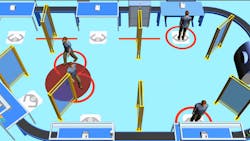Siemens Helping Manage Manufacturing's New Reality
The pandemic made it quite clear that there will soon be a new normal for manufacturers. As such, manufacturers are facing an array of challenges as they begin the process of restarting regular operations. While figuring out and ultimately navigating this new operational reality, manufacturers must consider additional dimensions of employee safety, including the establishment of production environments and workflows that address physical distancing requirements.
Combining proven hardware and software, Siemens has created a new solution that enables companies to quickly and efficiently model how employees interact with each other, the production line, and plant design. The new solution also enables organizations to build an end-to-end digital twin, in order to simulate worker safety, iterate on and optimize workspace layouts and validate safety and efficiency measures to help future-proof production lines.
With Siemens’ SIMATIC Real Time Locating Systems (RTLS), companies can continuously measure distances between workers, provide real-time visual feedback to employees regarding their spacing from others and create a log of all movements and interactions over time. In this way, the Siemens’ SIMATIC RTLS continuously facilitates safe distancing while providing numerous additional benefits.
"We've always talked about simulation. We've talked about doing things virtually before you do it physically, and I think this is critically important. Now more than ever, where you physically always can't be there, but you can do so much proof of concept work and stress testing embedding systems virtually in simulation tools. And while these inherently weren't designed for COVID-19 crisis, they're very relevant today," says Raj Batra, president of Digital Industries for Siemens USA.
Combining Siemens’ SIMATIC RTLS with a digital twin of the actual manufacturing environment permits companies to model and simulate how employees interact with the equipment and each other, enabling them to iterate and optimize safety and productivity in the short term, and validate a redesign of the entire operation before more costly physical changes are made.
By collecting real-time data manufacturers have the opportunity to drive the idea of continual iteration of the information collected during the validate stage, allowing them to analyze. resolve, and retest the updates on the production floor. So whether it's looking at traffic interactions, material flow or other production parameters, it's possible to drive updates to the line and simulate actual operations. This digital thread creates an opportunity to identify issues as they come up, drive the updates, and the implementation can happen relatively quickly.
“We are helping our customers create a safe work environment, which is extremely important as they look to produce efficiently and reliably under unprecedented circumstances,” said Tony Hemmelgarn, president and CEO of Siemens Digital Industries Software. “The combination of real-time distancing management and digital simulations will help companies maintain safe work environments today and make educated decisions about ongoing and long-term optimization.”
In order to implement this solution, Siemens’ SIMATIC RTLS transponders (with an accuracy of roughly one foot) are embedded in badges that are worn as personal protective equipment by all employees. RTLS receivers placed throughout the operation can then continuously track and record workforce movement. When two employees are in a risk scenario (e.g., less than six feet apart), their badges will display a warning, alerting them to the situation. The data collected over time can be analyzed to identify “hot spots” where risk scenarios occur frequently. Such situations become easily actionable via the digital twin, which is provided by Siemens’ Tecnomatix Process Simulate and Plant Simulation software. Utilizing the collected data, new manufacturing layouts or workflows can be simulated until one is determined to provide the desired outcomes, which can then be implemented in the physical operation.
Beyond this, manufacturers can add traceability to the solution through Siemens’ on-premise solutions or an application such as Siemens’ Trusted Traceability Application on MindSphere, the cloud-based, open IoT operating system from Siemens, which helps enable rapid, comprehensive contact analysis in the unfortunate event of an actual workplace illness. All movement and contact with the affected employee can be visualized, enabling rapid notification of those who came into close contact and selective (rather than site-wide) deep cleaning of exposed physical environments.
“Siemens is providing a powerful, rapidly deployable solution that helps manufacturers take control of their operations and achieve better safety, productivity, and cost outcomes today and in the post-COVID era,” said Batra. “Our solution consists of proven technologies that can begin delivering results for most manufacturers in one to two weeks.”
And as the code of crisis subsides, these technologies and tools can be redeployed in general manufacturing infrastructure. As such, this is not a technology, specifically for COVID-19. Instead, it's a technology that that has been adapted for COVID-19 for social distancing. This technology typically handles asset tracking, work in progress, logistics and applications production control, making it a technology manufacturers can utilize to optimize their processes.
About the Author
Peter Fretty
Managing Editor
As a highly experienced journalist, Peter Fretty regularly covers advances in manufacturing, information technology, and software. He has written thousands of feature articles, cover stories, and white papers for an assortment of trade journals, business publications, and consumer magazines.
